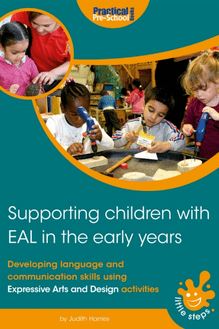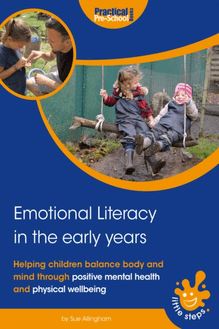Supporting Children with EAL in the Early Years , livre ebook
130
pages
English
Ebooks
2020
Vous pourrez modifier la taille du texte de cet ouvrage
Obtenez un accès à la bibliothèque pour le consulter en ligne En savoir plus
Découvre YouScribe et accède à tout notre catalogue !
Découvre YouScribe et accède à tout notre catalogue !
130
pages
English
Ebooks
2020
Vous pourrez modifier la taille du texte de cet ouvrage
Obtenez un accès à la bibliothèque pour le consulter en ligne En savoir plus
Publié par
Date de parution
16 décembre 2020
EAN13
9781912611409
Langue
English
Poids de l'ouvrage
7 Mo
Publié par
Date de parution
16 décembre 2020
EAN13
9781912611409
Langue
English
Poids de l'ouvrage
7 Mo
Supporting children with EAL in the early years
by Judith Harries
Published by Practical Pre-School Books, A Division of MA Education Ltd, St Jude’s Church, Dulwich Road, Herne Hill, London, SE24 0PB.
Tel: 020 7738 5454
www.practicalpreschoolbooks.com
© 2020 MA Education Ltd.
Original design: Mary Holmes fonthill creative 01722 717036
2020 digital version converted and distributed by Andrews UK Limited.
www.andrewsuk.com
All images © 2020 MA Education Ltd. except where noted.
All rights reserved. No part of this publication may be reproduced, stored in a retrieval system, or transmitted by any means, electronic, mechanical, photocopied or otherwise, without the prior permission of the publisher.
Introduction
This book presents guidance for EYFS practitioners, both new and more experienced, and aims to help settings create a stimulating learning environment that is welcoming and inclusive for all children. Children with EAL pose an exciting challenge to a setting, especially if there are several children, each with a different language. It is crucial that all children feel their language and culture are respected and valued and some cultural differences are outlined here to assist with this understanding.
The preliminary section includes helpful information on the early stages of learning English as an additional language and suggests many ways to support children with EAL and their families so that they feel accepted, secure and welcome. The role of the key worker is outlined as is the importance of home visits as a way to break down barriers.
The main objective of the book is to provide a unique and varied batch of creative activities for early years practitioners to use that involve ideas and skills from the Early Learning Goal for Expressive Arts and Design. These simple and practical activities are presented in an accessible format that staff can dip into and return to as an ongoing resource throughout the EYFS and continuing into KS1. Supporting children with EAL in the early years shows ways to help practitioners create a fully inclusive learning environment, where children with EAL will be able to access and engage in activities that all children enjoy. However, the book is an ideal resource for ‘all learners’, providing a wealth of opportunities for children to thrive and succeed at every level of communication.
Early stages of learning English
All children with EAL will learn English at their own pace, often dependent initially on how fluent they are in their home language. Many EYFS children are just coping with their first experiences of conversation with new peers and adults using their first language, so it can be particularly bewildering to be faced with the demands of a second language. There is debate as to whether children benefit from being completely immersed into the second language or encouraged to use both. This will depend on the provision at your setting. I feel that they should be encouraged to retain and develop their first language and many basic concepts will already have been learned and processed in the original language that can be applied to learning English.
Many of the activities in this book encourage children to share their home language as they go along. Remember to start with what each child already knows and are interested in, and use that as a way to develop their learning.
The first stage that many children with EAL go through is a ‘silent’ period, when they will use gestures, signs, and possibly some words in their home language. This is not a passive time as they will be actively listening and watching as they explore this new environment and often will be able to understand more than they can speak. It is important not to pressure them to speak at this time and be patient as it can last for up to six months. They may begin to echo particular words or short phrases such as ‘drink’ or ‘toilet’ and then go onto using small chunks or phrases with meaning such as ‘My turn’, ‘Home soon’ or ‘Mummy come now?’ They may start to join in with refrains in stories, songs and rhymes and lots of group singing at this stage can encourage them to ‘have a go’ without worrying about being heard. Imitation is a key part of learning and they will enjoy copying the other children’s words and actions.
Correct intonation and prosody can emerge before meaningful sentences. Basic question words are some of the first to be used along with independent phrases such as ‘I like…’ or ‘I want…’. Encourage ‘scaffolding’ when the listener sympathetically supplies any missing words or phrases to support emerging conversation.
Chapter One: EAL in the early years
Positive relationships
Setting and home visits
Most settings will encourage children and their parents to visit on at least one occasion prior to their starting date so that the children are familiar with some adults, the layout of the building and other practicalities. Starting at a new setting is a scary time for both the child and the parents/carers, and not being able to communicate, understand what is being said, or read letters and notices can make it worse. Put up welcome signs in multiple languages, introduce key workers and set out a mix of familiar, favourite, and fun activities for children to explore.
Many settings also offer a ‘home visit’ and these can be invaluable for establishing a partnership between home and setting. The key worker can meet the child in his or her own environment and find out about toys, interests, pets, and siblings, as well as key pointers about their cultural background. It’s a good opportunity to get to know parents and try to help them feel they can approach the key worker with any concerns.
Home visits should always involve two members of staff including one who knows some of the child’s home language if possible. Take along photos of the setting to talk about and a puppet or toy to help interaction with the child. Use this opportunity to help parents fill in any paperwork, including medical and dietary requirements and fill in an information sheet with details about the child’s name (spelling and pronunciation is really important), their main likes and dislikes, the language the parent uses with the child, and any religious and cultural beliefs. Some families will not want a home visit and this view should of course be respected.
The role of the key worker
The key worker has a particularly important role in forging ‘positive relationships’ when working with EAL children and their families. It starts at the pre-visit or home visit and it is important to quickly establish a friendly and approachable manner with parents/carers and child. Make sure you know how to pronounce the child’s name, learn how to greet the family in their home language if you can, and be aware of some of the child’s interests. Refer back to facts you learned at the home visit. Support services are available from local authorities to help settings support EAL families such as Ethnic Minority Achievement (EMA) teams.
If the child is starting mid-term, pair them with a child or supportive group that you trust, as they will be a friendly guide or provide role-models. Don’t expect or demand speech too early and allow for a period of silent but active listening as they adjust. Use lots of non-verbal cues and have picture fans to hand. Have a digital tablet available so you can check online translations and allow children to hear their home language. Take care not to misinterpret facial expressions or gestures and be sensitive to cultural differences with regard to personal space (see Cultural differences ). Spend one to one time helping the child become familiar with routines, such as snack and playtime, where the toilets are situated, hanging up belongings on peg, and so on.
The child with EAL
What a child in your setting may be thinking…
Enabling environments
Creating a suitable environment for learning
Every early years setting seeks to create a stimulating environment for learning that is inclusive and helps children to feel safe, supported and engaged. The first step is to aim for positive relationships between practitioners, children and parents, and between the children themselves.
It is always important to observe children in order to inform planning and provide appropriate activities that foster their interests and develop their learning. Activities should be accessible, challenging and achievable.
Ways to support children with EAL and their families
The key thing to remember is to celebrate the linguistic diversity that children with EAL and their families bring to your setting. Provide a range of opportunities for children to use their home language so that the development of English and other languages support one another.
‘Supporting continued development of first language and promoting the use of first language for learning enables children to access learning opportunities within the EYFS and beyond through their full language repertoire.’ (Primary National Strategy, 2007)
Aim to provide play and learning resources that reflect children’s cultural identity, for instance books, posters, labels and role-play equipment. Provide signs and notices in the home language for children and their families and offer translation services if required.
Ensure there are plenty of opportunities to use an outdoor area as children are often less inhibited when using language in an outdoor environment. Many of the creative activities in this book can be taken outside.
‘Practitioner observations have shown that children commonly make at least five times as many utterances outdoors as they do inside.’ (Primary National Strategy, 2007)
Remember to use no

